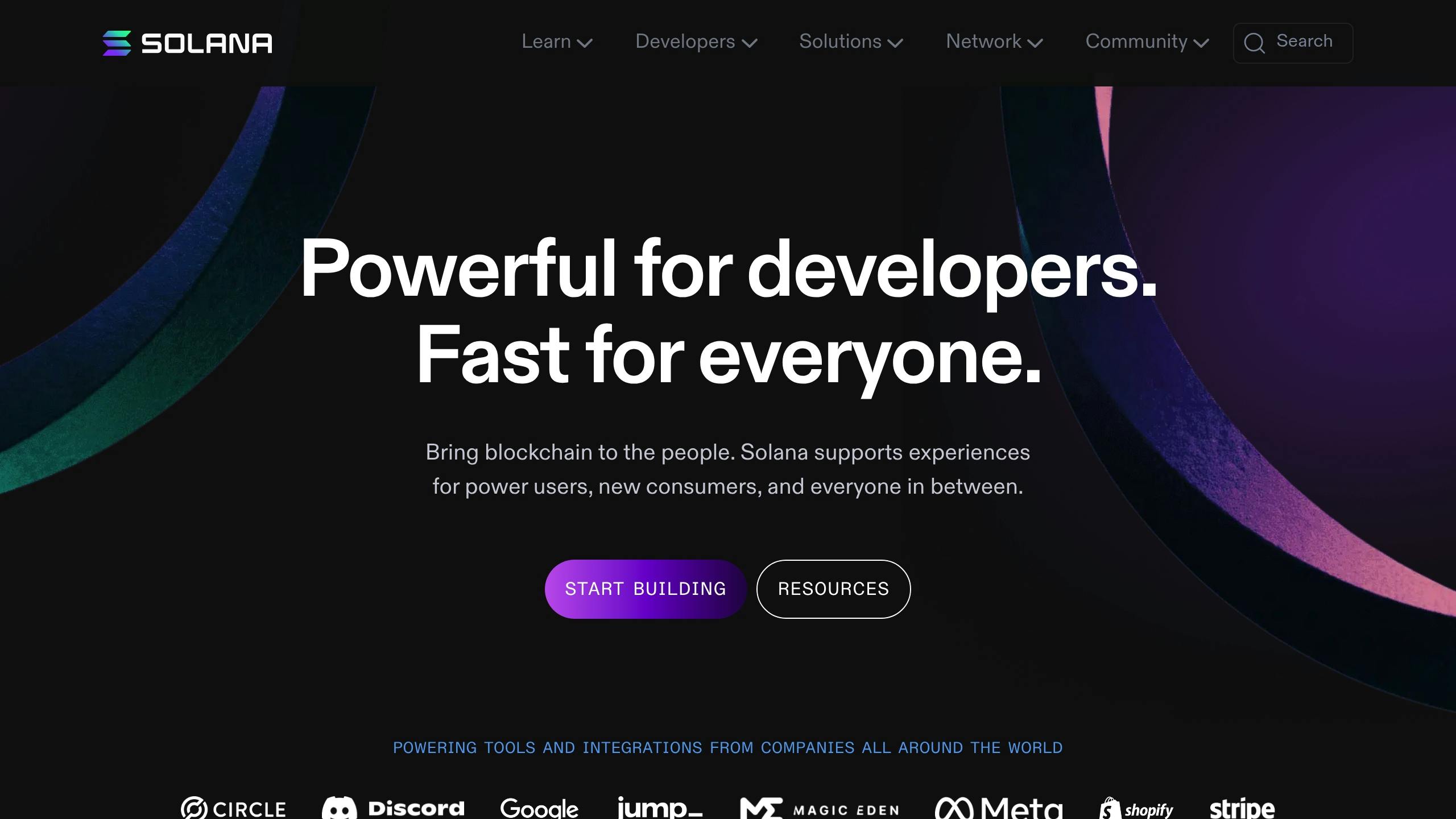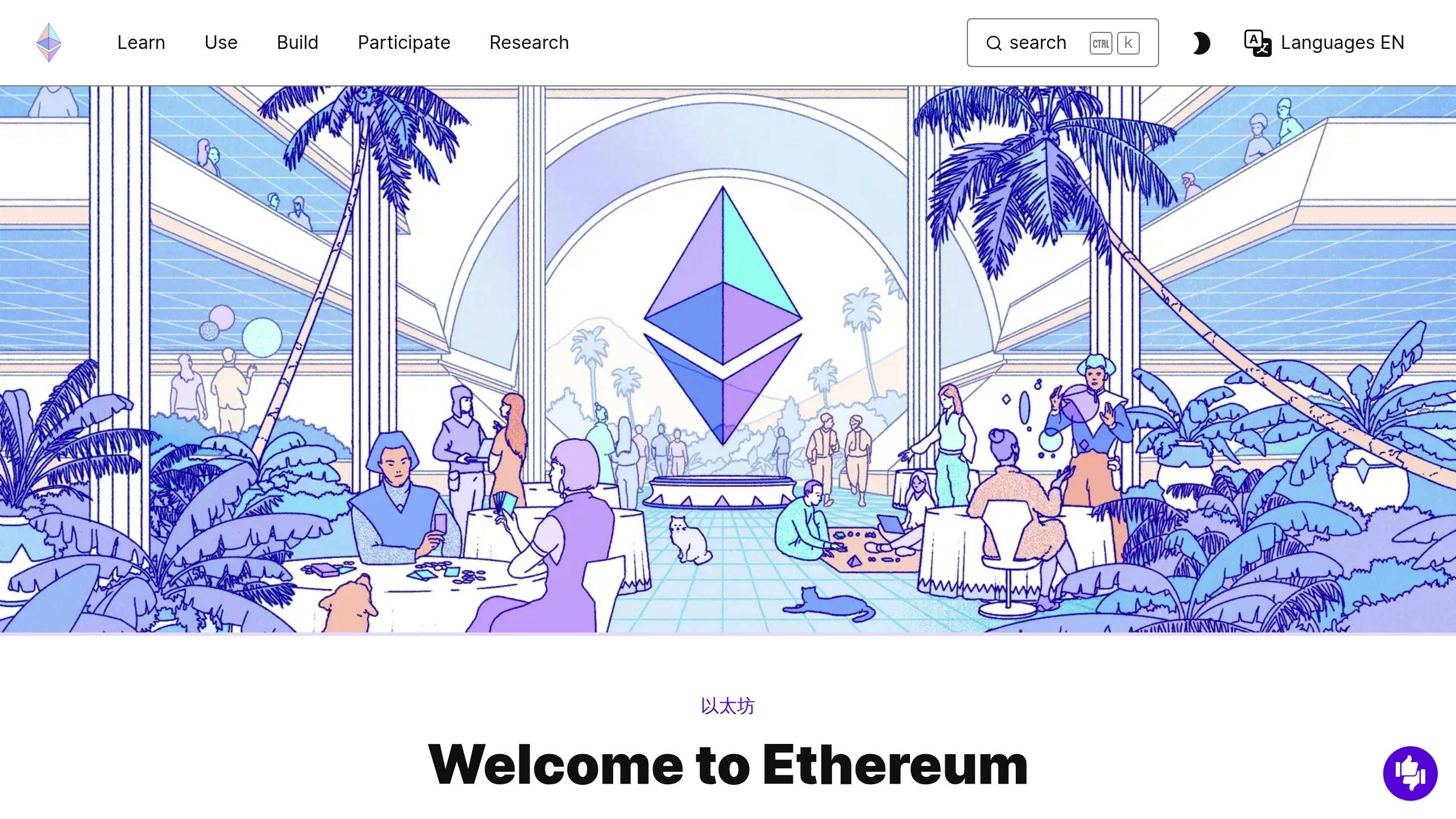Choosing between Solana and Ethereum (EVM) for blockchain development depends on your project’s needs. Solana offers speed and low costs, while Ethereum provides security and a mature ecosystem. Here’s a quick breakdown:
Key Differences:
- Transaction Speed: Solana handles 2,600+ TPS with sub-second finality; Ethereum processes 15-30 TPS (base layer).
- Fees: Solana’s average fee is $0.00025, while Ethereum’s Layer 2 fees range from $0.1-$0.5.
- Development: Solana uses Rust (faster but harder to learn), while Ethereum uses Solidity (easier for beginners).
- Ecosystem: Ethereum dominates DeFi with tools like Hardhat and MetaMask. Solana excels in retail trading with platforms like Pump.fun.
- Network Reliability: Ethereum has had no outages since 2016, while Solana is improving stability with upgrades like Firedancer.
Quick Comparison:
| Feature | Solana | Ethereum (EVM) |
|---|---|---|
| Transaction Speed | 2,600+ TPS | 15-30 TPS (base layer) |
| Average Fee | $0.00025 | $0.1-$0.5 (Layer 2) |
| Development Language | Rust | Solidity |
| Ecosystem Strength | Retail & High-Speed Apps | Institutional DeFi |
| Network Reliability | Improving (Firedancer) | Highly Stable |
| Wallet Support | Phantom | MetaMask |
| TVL (Feb 2025) | $2.5B | $40B |
Who Should Choose What?
- Pick Solana for fast, low-cost, retail-focused apps like high-frequency trading or NFT platforms.
- Pick Ethereum for secure, DeFi-heavy, and institutional-grade applications.
Both platforms are evolving, with Solana focusing on stability and Ethereum refining its efficiency. Your choice depends on your project’s priorities: speed and cost vs security and ecosystem maturity.
Technical Design: Solana vs EVM

Speed and Network Security
Solana leverages its Proof of History (PoH) system to achieve over 2,600 transactions per second (TPS) with sub-second finality. In contrast, Ethereum’s base layer processes 15 TPS, prioritizing decentralization with its validator network that’s 500 times larger. The decentralized timestamping in PoH is a key factor behind Solana’s impressive throughput[5].
| Network Feature | Solana | Ethereum |
|---|---|---|
| Transaction Speed | 2,600+ TPS | 15 TPS (base layer) |
| Block Time | 400ms | 12 seconds |
| Finality Time | 1-2 seconds | 12-15 minutes |
Transaction Costs and Speed
Ethereum’s Layer 2 solutions bring transaction costs down to $0.1-$0.5, but they add complexity without reaching Solana’s native speed and cost efficiency[8]. This difference is especially important for activities like leverage trading, where quick adjustments are critical.
Single vs Multi-Chain Ecosystem
Solana’s single-chain architecture simplifies user interactions by eliminating the need for cross-chain bridges. This unified design supports seamless composability between applications, making it ideal for high-frequency trading strategies that rely on shared liquidity[10].
On the other hand, Ethereum’s multi-chain ecosystem offers flexibility but introduces challenges. Users often deal with complex asset bridging across Layer 2 solutions, and liquidity is fragmented across these layers. This makes transaction execution more complicated compared to Solana’s unified state[5].
"Solana’s high throughput enables more on-chain data storage, reducing Layer 2 dependencies compared to Ethereum’s cost-driven off-chain solutions."
Solana’s Sealevel runtime allows parallel transaction processing, unlike Ethereum’s sequential execution model. This parallelism boosts Solana’s throughput while maintaining security through its PoH-based consensus. These architectural differences also influence how developers approach building on these platforms, a topic explored in the next section.
Solana vs Ethereum: Battle for Blockchain Supremacy

Development Tools and Support
The differences in architecture between Solana and Ethereum directly shape their developer ecosystems, influencing language preferences and available tools.
Rust vs Solidity Development
For DeFi developers, choosing between Solana’s Rust and Ethereum’s Solidity involves weighing pros and cons. Solidity, specifically designed for smart contracts, is easier for blockchain newcomers to pick up. Rust, on the other hand, is harder to learn but offers better memory safety and performance.
The developer community numbers tell an interesting story. Ethereum boasts a strong base with over 4,000 monthly active developers, while Solana has around 350 active developers[1]. That said, Solana’s developer activity has grown by 40% in 2024, showing promising momentum[2].
Development Resources
The gap in maturity between the platforms is clear when looking at development tools. Ethereum’s Hardhat framework is a favorite, with 1.5 million weekly downloads on npm[3]. Solana’s web3.js SDK, while growing, sees about 50,000 weekly downloads[9].
| Development Feature | Ethereum | Solana |
|---|---|---|
| Primary Framework | Hardhat (1.5M weekly downloads) | web3.js (50K weekly downloads) |
| Testing Tools | Ganache, Remix, Truffle | Solana Playground |
Ethereum also provides well-structured, beginner-friendly documentation, while Solana’s resources are improving but still somewhat scattered.
Wallet Support and Integration
Wallet integration is a crucial aspect of DeFi app development. MetaMask leads the pack with 30 million monthly active users and robust multi-chain support[5]. Strong wallet integration is essential for smooth leverage trading and quick position management.
"Rust’s memory safety reduces certain vulnerability risks, offset by its steeper learning curve."[11]
Cost is another key factor. Deploying a smart contract on Solana costs about 0.00045 SOL, while Ethereum deployment fees range from $20 to $100, depending on complexity[6]. This lower cost on Solana allows for quicker iteration cycles, which is a big advantage for trading platforms.
Money Flow Changes After Pump.fun
Ethereum’s advanced tools cater well to institutional DeFi users, but Solana gained significant traction with retail users after the launch of Pump.fun in 2023.
TVL Changes Q4 2023
Solana’s ecosystem saw a major boost, with its Total Value Locked (TVL) jumping 203% in Q4 2023, reaching $2.97 billion by January 2024[1]. In comparison, Ethereum’s TVL grew by 22% during the same period, climbing to $28.51 billion[3]. Notably, Pump.fun contributed to 41% of Solana’s TVL growth during this period[1]. This influx of liquidity has directly impacted leverage trading pools on Solana’s decentralized exchanges (DEXs).
| Network | TVL Growth | TVL January 2024 |
|---|---|---|
| Solana | 203% | $2.97B |
| Ethereum | 22% | $28.51B |
Additionally, the average transaction size on Solana dropped by 20% to $360, while its throughput reached an impressive 5,000 transactions per second (TPS)[4].
"The success of Pump.fun has fundamentally altered DeFi yields across the Solana ecosystem, creating competitive conditions for leveraged yield farming strategies"[10].
User Base Differences
After Pump.fun’s launch, Solana experienced a 65% spike in retail wallet activity[9]. Retail users now make up 80% of Solana’s user base, compared to Ethereum’s 55%[9].
Solana’s users tend to be younger, with an average age of 28, and show 40% more participation from emerging markets[5]. By December 2023, Solana’s active addresses hit 730,000, surpassing Ethereum’s 527,000, highlighting a clear retail preference for Solana’s fast-paced trading environment[7].
sbb-itb-dd9e24a
DEX Platform Differences
The structural design of Solana and Ethereum creates unique trading experiences on their respective decentralized exchanges (DEXs), shaping how users interact and trade.
Speed and Cost Metrics
Solana-based DEXs excel in transaction speed, offering near-instant execution times of about 400ms. This is a big advantage, especially during periods of high trading activity.
| Metric | Solana DEXs | Ethereum DEXs |
|---|---|---|
| Transaction Speed | 400ms | 15-30 seconds |
| Order Execution | Near-instant | Variable (network dependent) |
This faster performance opens the door for trading strategies that rely on quick execution, as highlighted in the Network Safety and Uptime analysis.
Liquidity Distribution
Solana’s single-state architecture gives its DEXs an edge in liquidity management. Unified liquidity pools allow for better capital efficiency and lower slippage compared to Ethereum, where liquidity is often fragmented across Layer 2 solutions. This design aligns well with Solana’s focus on retail traders, as noted in the Money Flow Changes section.
That said, Ethereum holds the lead in total liquidity, boasting a total value locked (TVL) of $40 billion versus Solana’s $2.5 billion as of February 2025 [3]. This deeper liquidity is particularly advantageous for institutional traders and large-scale transactions.
Leverage Trading Options
The two platforms have developed different approaches to leverage trading, reflecting their underlying architecture:
- Solana DEXs: Offer rapid execution (under one second) and lower transaction fees.
- Ethereum DEXs: Provide higher maximum leverage (up to 125x) and advanced risk management tools tailored for institutional use.
- Cross-chain integration: Ethereum features more established bridge infrastructure, enabling complex multi-protocol trading strategies.
These differences highlight how each platform caters to distinct trader needs, from retail users prioritizing speed to institutional players requiring advanced tools and liquidity.
Network Safety and Uptime
Network Downtime Analysis
In 2022, Solana experienced 14 outages, a stark contrast to Ethereum’s uninterrupted performance since 2016. Efforts like the Firedancer upgrade aim to address this disparity[1][7][12]. Most of Solana’s outages stemmed from transaction overload during periods of market volatility. These disruptions have real consequences: a 2023 study found that forced liquidations during Solana outages were 63% higher compared to similar events on Ethereum[14].
| Improvement | Purpose |
|---|---|
| Firedancer | Boosts network stability and resilience[1] |
Network Security Design
The way these networks are built also plays a key role in their reliability. Ethereum relies on a vast number of validators, which minimizes single points of failure. In contrast, Solana’s design achieves faster consensus but comes with centralization risks, partly due to its higher hardware requirements.
Firedancer, an upcoming upgrade for Solana, is designed to:
- Minimize risks of network-wide failures
- Boost transaction processing capabilities
- Improve resistance to MEV (Miner Extractable Value) attacks, which are common in high-frequency trading
"The Firedancer implementation marks a crucial step in Solana’s evolution toward improved network resilience. By introducing client diversity, we’re significantly reducing the risk of network-wide failures due to bugs in a single client implementation."[13]
Ethereum’s higher staking requirement ($64,000 compared to Solana’s $6,400) reflects its focus on security through decentralization[3][12]. This difference highlights the networks’ philosophies: Ethereum emphasizes security and decentralization, while Solana prioritizes speed and is working to enhance stability. Firedancer’s success will be key for Solana to attract institutional users seeking reliability on par with Ethereum for leverage trading platforms.
Platform Strengths and Focus
Solana’s Speed-Driven Approach
Solana stands out for its incredible transaction speed and low costs, offering sub-second finality and micro-fee transactions. This makes it ideal for retail users needing institutional-level trading speeds. A prime example is Serum DEX, which achieves millisecond trade executions thanks to Solana’s infrastructure[1][7]. This kind of performance is especially useful for applications like leverage trading, where speed is critical.
Serum DEX showcases how Solana’s infrastructure supports lightning-fast trades, delivering a trading experience similar to centralized exchanges, but with the benefits of decentralization[3].
Another example is Magic Eden, Solana’s top NFT marketplace, which handled over 10 million transactions in a single day in January 2025[3]. This highlights Solana’s ability to handle high transaction volumes with ease, making it a natural fit for retail-focused, high-demand applications.
Ethereum’s DeFi Expertise
Ethereum, on the other hand, has cemented itself as the backbone of decentralized finance (DeFi). Its well-established ecosystem supports protocols like Aave and Compound, which collectively manage billions in assets. These platforms benefit from Ethereum’s security-first design, ensuring reliability and trust in handling large-scale financial operations[9].
Ethereum’s multi-chain ecosystem offers flexibility but comes with added complexity compared to Solana’s more unified network design. This trade-off reflects the balance between offering advanced features and maintaining a straightforward user experience[1][3].
Conclusion
Key Differences
When comparing Solana and Ethereum, their contrasting designs lead to clear advantages in specific areas. Solana’s infrastructure supports over 2,600 transactions per second (TPS) with incredibly low fees averaging just $0.00025. This makes it an appealing choice for applications that demand fast execution and cost efficiency[1]. On the other hand, Ethereum processes 15-30 TPS, with Layer 2 fees ranging from $0.1 to $0.5. Despite this, Ethereum stands out for its established ecosystem and leadership in decentralized finance (DeFi)[5][8].
| Feature | Solana | Ethereum |
|---|---|---|
| Transaction Speed | 2,600+ TPS | 15-30 TPS |
| Average Fee | $0.00025 | $0.1-$0.5 (Layer 2) |
| Strengths | Speed & Low Cost | Security & DeFi Expertise |
These differences shape how capital flows within their ecosystems. Solana tends to attract retail traders due to its speed and affordability. Ethereum, meanwhile, remains the go-to platform for institutional DeFi applications, offering a high level of security for leverage trading[8]. Solana, however, shines in high-frequency trading scenarios, where low latency and minimal costs are essential[3][5].
Future Developments
Both platforms are actively working on improvements. Solana’s Firedancer upgrade is set to boost network reliability and increase transaction capacity[11]. Ethereum continues refining its proof-of-stake (PoS) system, aiming to balance security with greater efficiency[1].
These advancements highlight their complementary roles in the blockchain space. Solana appeals to retail users prioritizing speed and affordability, while Ethereum remains a top choice for institutions focused on security and DeFi sophistication[5].
FAQs
Is Solana built on EVM?
No, Solana doesn’t operate on the Ethereum Virtual Machine (EVM) by default. This structural difference influences how leverage trading functions, as outlined in our DEX Platform Differences analysis.
To bridge the gap, developers use tools like Neon EVM, which allows Ethereum dApps to run on Solana. This has been key in bringing Ethereum-native liquidity to Solana DEXs, especially since the launch of Pump.fun [7][3]. While Solana’s native development relies on Rust, tools like Neon EVM make it possible to deploy Solidity contracts with minimal adjustments, taking advantage of Solana’s high-speed performance [7][3][8].
